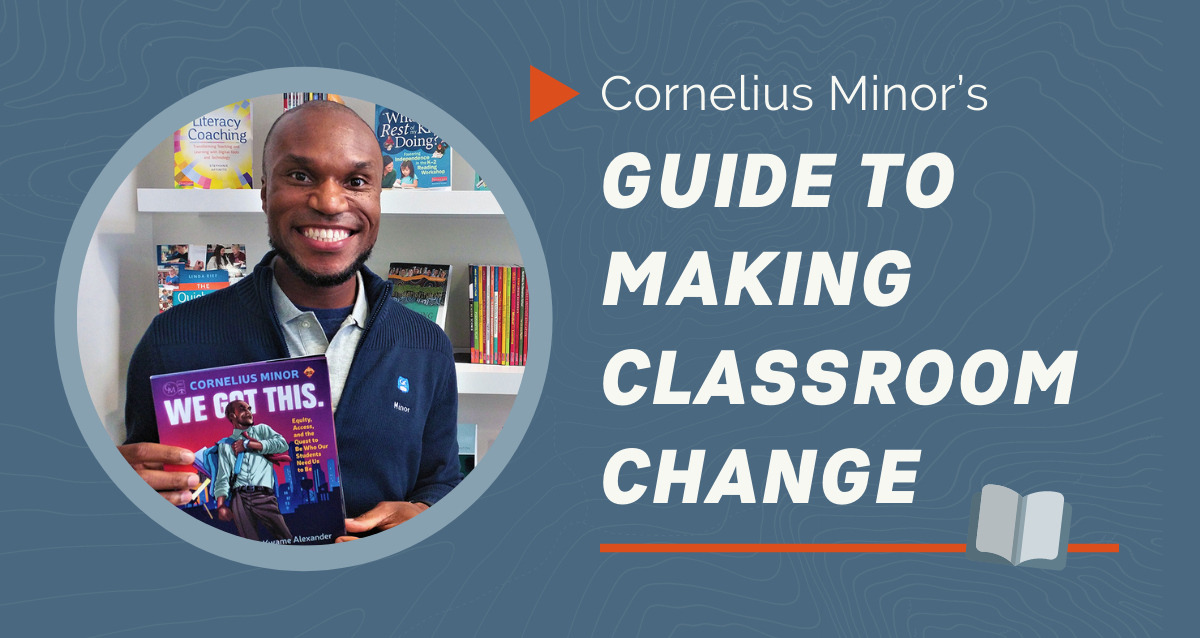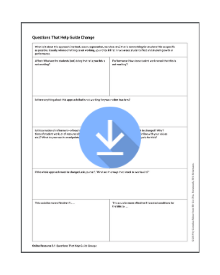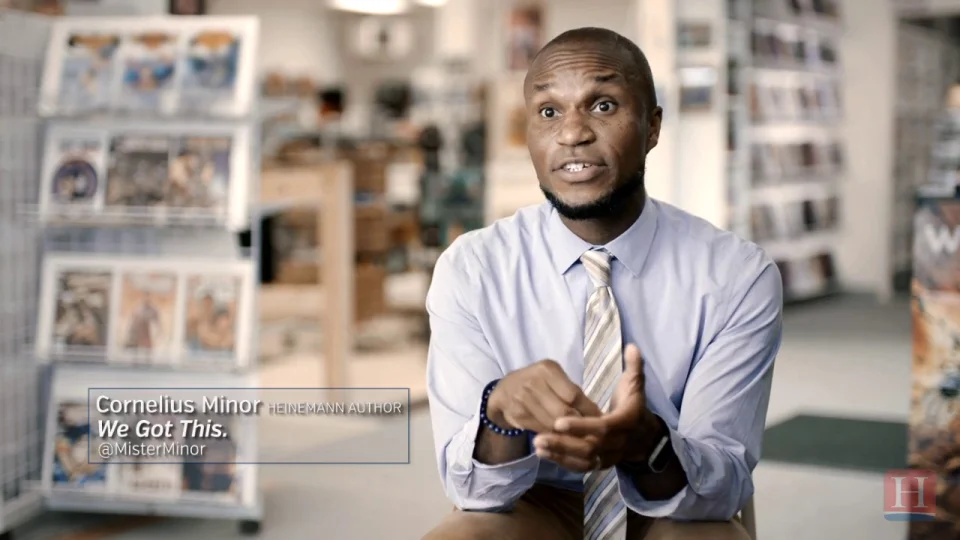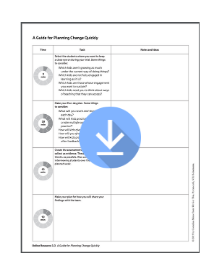 Thoughtful teachers make subtle changes every day. They adjust their teaching to meet students’ needs. They implement new ideas from other educators. Maybe they incorporate a technique suggested by the latest classroom research. But what do thoughtful teachers do when they realize that they need to make a bigger change because something they’ve relied on isn’t working for their students anymore?
Thoughtful teachers make subtle changes every day. They adjust their teaching to meet students’ needs. They implement new ideas from other educators. Maybe they incorporate a technique suggested by the latest classroom research. But what do thoughtful teachers do when they realize that they need to make a bigger change because something they’ve relied on isn’t working for their students anymore?
Sometimes the things that we have to do become tradition, and as tradition ages sometimes those practices do not serve all children. Sometimes we have to change an established way of doing things in order to better serve our kids.
In Chapter 3 of We Got This, Cornelius Minor (@MisterMinor) provides a step-by-step guide to making these larger scale adjustments. Cornelius provides much more in the book, but we’ve excerpted parts of the book below so that you can test drive his ideas in your classroom.
To learn more about We Got This: Equity, Access, and the Quest to Be Who Our Students Need Us to Be visit Heinemann.com.
The following has been excerpted from Cornelius Minor's We Got This:
Identify Why Change Needs to Happen
Sometimes a thing needs to change because it is not reaching students in the way I want to reach them. I may not be seeing the growth I want or the engagement that they need. When I notice such trends, I’ve got to ask myself some very important questions, like the ones included in the Questions That Help Guide Change form below. These questions can sometimes take weeks to answer, and that is OK. Designing a powerful approach to a problem is potent change work.
 Once I’ve asked myself these questions, I take a look around me. Am I in a place where it is safe for me to do change work openly? Do people here welcome new thinking? Is there a process or protocol for proposing new ideas to my group? Or could my venture be met with hostility? Whatever the answer, I know that I always need information to proceed.
Once I’ve asked myself these questions, I take a look around me. Am I in a place where it is safe for me to do change work openly? Do people here welcome new thinking? Is there a process or protocol for proposing new ideas to my group? Or could my venture be met with hostility? Whatever the answer, I know that I always need information to proceed.

Do a Little Bit of Research
Once you’ve decided that change needs to be made, it’s important to think about the kind of change that would benefit your students most. It’s easy to fall back on things that we know well or on the ways that we were taught when we were in school. It is important to ask, “Are those things really best for our students?” Sometimes you’ll have a hunch about what to do to make improvements. This is not the time for “spend hours reading everything in the world” reading; this is you taking twenty minutes online to read up on your topic by browsing blogs, articles, and social media posts from credible people in the field. This is where reading a great professional book on your topic can help.
Decide What to Do and Make a Plan
A little bit of research combined with your original hunch can be all you need to make a decision. If you are lucky enough to have a coach, mentor, or trusted colleague, you can talk to them about what you have learned so far. If you are in a situation where change is an articulated process, now is the time to get yourself on the agenda or ask for a meeting with the parties that can help you to realize your vision. If you are in a place where change might be met with various forms of hostility, this is when you use the research you just did to provision yourself for the journey ahead.
Once you’ve decided what you want to do, you’ve got to plan for it and prepare some of the materials you’ll need to make it happen. Try not to let your planning and preparation exceed sixty minutes in this part, unless you are conducting a major curricular or programmatic overhaul. The first round of your planned change involves collecting the data that will lead to larger, more lasting changes later on. For now, there are a few things you need to do:
1. Imagine how this change might happen. Be real about the community where you work and think about how change usually happens. Whom will you need as an ally? What processes will you choose to follow or ignore? Is this process usually one where the community gathers around an idea, or do ideas usually float down from the top? Do people even care what happens in your classroom or will your ideas be opposed openly? Whatever your answers to these questions are, these first five steps in the change process happen alone or with a small team. Here, you’ll be learning all about the change that you want to make. Does it even work? How does it impact kids? That way when you go to propose your change, you won’t be proposing an idea. You’ll be proposing data-informed practice.
2. Select a small population of students to study. You’ll be attempting something that will potentially impact a whole class, but as you do, you’ll want to have your eyes on certain students so that you can gauge and eventually communicate the impact that your work has on student growth. In a class of twenty-five to thirty-two students, I’ve historically chosen about five to study. You’ll want to select students from across several groups so that you can test your work across the populations that constitute your classroom. I often think about selecting a student who is new to English, a student who might be performing below grade level, one who might be at or above grade level, and a kid who has an IEP that feels decently representative of the IEPs that I see most often. Other groups might come to mind as you consider the changes that you want to make, but later on it will be imperative for you to communicate the impact that your work has had on the populations of students who need to grow the most.
3. Make a five-day plan for how you will implement the changes you have chosen. Five days feels like the right amount of time to give you a vision of what a large-scale version of this change can look like. During these five days, you can try everything, and you’ll have enough time to begin to see some changes in your students, via their work, talk, affect, and thinking.
4. Choose how you will measure the impact that your work is having on students. Anyone can make change, but to make persisting change, we’ve got to be able to measure and articulate its value. It helps to collect student work and testimonials, from those in the groups that you have chosen to study. Additionally, having examples of the lesson plans that you used to guide students to this work is necessary for helping colleagues to embrace your innovation later on. You should be able to answer the questions, “Is this better for students than the other way?” and “If we do it this new way, can we make comparable gains?”
5. Decide how you will share your findings. Will it be in a department meeting? One-on-one with the department chair, team leader, or principal? Or will you float the idea to a representative so that they may take it to the school leaders for you? Are you preparing for some passionate debate, or a “do whatever you want” conversation, or a full-on fight?
Now that I have all of these good ideas and suggestions, I’ve got to fashion them into a cohesive whole so that I’m not just supplementing a curriculum that does not work for my students with a bunch of random activities. Check out this Planning Change Quickly guide:
Execute the Plan
Try it. It won’t all go well. That’s to be expected, so you’ll be making active revisions as you go. Observe everything and reflect. Often. When I’m in this part of my work, I try to remember that I’m doing this for my students, yes, but I’m potentially doing this for every teacher on the grade team or in the school, so I want to keep examples of everything and I want to start crafting the story of how this work came to be, why it came to be, and how it can go for everyone else.
…
When people hear you talking like this, and they understand that you base your classroom decisions on research and on data generated from practice in your classroom, you’ll find that they will listen to you more. This kind of leadership improves discourse across a whole teacher team. Others will notice your methods, and dialogue will become richer, because you’ll raise the bar. Though conversations will be hard, they will be productive. Change will take root, because you listened.
…
Learn more about We Got This at Heinemann.com
 Cornelius Minor is a frequent keynote speaker for and Lead Staff Developer at the Teachers College Reading and Writing Project. In that capacity, he works with teachers, school leaders, and leaders of community-based organizations to support deep and wide literacy reform in cities (and sometimes villages) across the globe. Whether working with teachers and young people in Singapore, Seattle, or New York City, Cornelius always uses his love for technology, hip-hop, and social media to recruit students’ engagement in reading and writing and teachers’ engagement in communities of practice. As a staff developer, Cornelius draws not only on his years teaching middle school in the Bronx and Brooklyn, but also on time spent skateboarding, shooting hoops, and working with young people.You can follow Cornelius on Twitter @MisterMinor
Cornelius Minor is a frequent keynote speaker for and Lead Staff Developer at the Teachers College Reading and Writing Project. In that capacity, he works with teachers, school leaders, and leaders of community-based organizations to support deep and wide literacy reform in cities (and sometimes villages) across the globe. Whether working with teachers and young people in Singapore, Seattle, or New York City, Cornelius always uses his love for technology, hip-hop, and social media to recruit students’ engagement in reading and writing and teachers’ engagement in communities of practice. As a staff developer, Cornelius draws not only on his years teaching middle school in the Bronx and Brooklyn, but also on time spent skateboarding, shooting hoops, and working with young people.You can follow Cornelius on Twitter @MisterMinor





